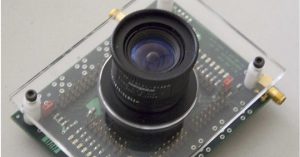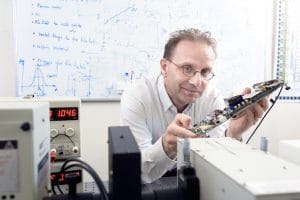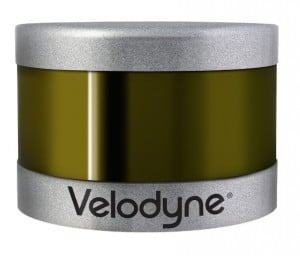
A Swiss team of scientists in concert with Japanese camera maker Canon developed a new camera to take photos of photons.
A team of physicists in Switzerland has built what they describe as the world’s first megapixel photon-counting camera and a first-of-its-kind image sensor technology, which could make lidar systems faster and more accurate.
Lidar, a surveying method that measures distance to an object by illuminating the target with laser light and measuring the reflected light with a sensor, is widely considered one of the fundamental building blocks of autonomous vehicles.
The photon system developed by the Swiss team is capable of detecting single photons of light at record speeds.
(GM applies for patent on new mapping technology.)
The technology was developed by engineers at the Advanced Quantum Architecture Laboratory in Switzerland, could be used to improve the resolution of augmented reality or the efficiency of lidar systems for self-driving cars, according to its developers.
The camera is described in a recently published research paper.

Edoardo Charbon, researcher with the Swiss Federal Institute of Technology, says the new technology may improve lidar technology.
“Thanks to its high resolution and ability to measure depth, this new camera could make virtual reality more realistic and let you interact with augmented reality information in a more seamless manner,” Edoardo Charbon, researcher with the Swiss Federal Institute of Technology in Lausanne and AQUALab, said in a news release.
The camera’s breakthrough technology is powered by single-photon avalanche diodes, or SPADs. In addition to shrinking the SPAD pixels to record size, engineers also succeeded in reducing the amount of power that each pixel uses.
As a result of the technology upgrades, the camera can achieve record speeds – acquiring images at up to 24,000 frames per second – while maintaining impressive timing precision and energy efficiency, developers said.
“For transportation applications, this new camera could help achieve unprecedented levels of autonomy and safety by enabling multiple low-power lidar devices to be used on a vehicle, providing fast, high-resolution 3D view of the surroundings,” said AQUALab researcher Kazuhiro Morimoto, who also works as an engineer for Canon Inc. in Japan.
(Karma unveils new autonomous platform.)
“In a somewhat more distant future, quantum communication, sensing and computing could all benefit from photon-counting cameras with multi-megapixel resolution.”
SPADs work by detecting single photons and converting them into electrical signals. For the latest research, scientists were able to construct an array of extremely small SPADs.
Each SPAD sensor found in the new camera can open and close at record speeds, allowing light in for just 3.8 nanoseconds, roughly four billionth of a second.
To efficiently process the electrical signals produced by the SPAD sensors, engineers deployed integrated circuits to catch the images.
The energy demands of similar technologies have limited the size of previous sensor arrays. By improving the energy efficiency of each sensor, engineers were able pack the SPAD sensors more densely, yielding an array featuring millions of pixels.
“To the best of our knowledge, the spatially overlapped multi-object detection with the single-photon time-gating scheme has been experimentally demonstrated for the first time,” researchers wrote.
The speed and precision of the new camera makes it possible to measure the amount of time it takes for a photon to travel from its source to the camera’s sensor, as well as produce high-speed reconstruction of 3D images. Scientists confirmed the accuracy of the camera’s time-of-flight measurements using laser pulses.
(GM ramping up broad roll-out of semi-autonomous Super Cruise.)
“Owing to its noise and dynamic range performance, the proposed sensor will be useful in a wide variety of industrial applications, such as security, automotive, robotic, biomedical, and scientific applications, including quantum imaging and ultra-high-speed imaging,” researchers wrote.

